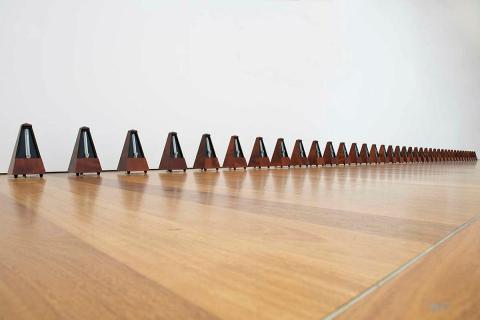Martin Creed: Work no. 189
By David Burnett
Artlines | 3-2008 | September 2008
Publisher: QAGOMA | Editor: Ian Were
British artist Martin Creed's pared-back approach to making art — adapting everyday situations or objects — reflects many of the ideas underpinning the collection of Fluxus multiples and works gifted to the Queensland Art Gallery in the 1990s by Italian collector and publisher Francesco Conz. Work no. 189 is an important early work and one that resonates strongly with existing works in the Collection.
Creed's approach to making art reflects the trend of re-configuring and re-contextualising ordinary, everyday events, objects or situations to create a moment of pause, or an opportunity to reconsider something taken for granted as extraordinary. Martin Creed, perhaps notoriously, came to international attention when his Work no. 227: The lights going on and off was awarded the distinguished, but often controversial, Turner Prize in 2001. More recently he has orchestrated a work for the prestigious Duveens Commission at Tate Modern, in which a team of athletes complete an 86-metre sprint through the gallery every 30 seconds.
Work no. 189 2004 is one of two works by the artist utilising metronomes as the units of a sculpture (the other, Work no. 112 1995–2004 was acquired by the Tate Modern in 2005). Comprising 39 metronomes, Work no. 189 relies on the accumulation and presentation of identical units as serial elements in a single work. While seriality, music and, of course, time have an integral relationship in this work, Creed also establishes historical connections with other artists: Marcel Duchamp and his 'ready-mades'; and Man Ray's well known and iconic surrealist Object to be destroyed, a metronome to which a photograph of an eye was affixed, first produced in 1923.
The metronome was invented by Dietrich Nikolaus Winkel in Amsterdam in 1812 and then patented by Johann Nepomuk Malzel in 1816, and it has changed little since then. The metronome is a clockwork mechanism employing a weighted, adjustable pendulum which can be set to audibly indicate the exact tempo of a musical composition. Although there are now digital devices, the analogue version is the object of choice for Creed. Its pyramidal form and wooden casing is inherently 'sculptural' and their rigid organisation into a straight line is playfully militaristic. In its final realisation, however, Creed's work undermines and confounds the apparent precision and intended application of the devices. Each metronome is set and calibrated incrementally across the full spectrum of their tempo speeds (from fast, presto, to very slow, lento) so that, when in full operation, each device beats simultaneously in a different tempo producing a rhythmical cacophony.
As analogue mechanical devices need to be periodically wound, the units progressively lose their pendulum momentum and eventually stop at unpredictable points, adding to the paradoxical humour. The dissonant and repetitive nature of the work also recalls music by twentieth-century avant-garde composers such as John Cage (a critical figure in twentieth-century avant-garde art), Terry Riley and Steve Reich, whose compositions utilise chance, repetitive pulses and dissonance.
Creed's particular sensibility is primarily sculptural. His practice is informed by minimalist and conceptual artists of the 1960s and 1970s, such as Sol LeWitt, Donald Judd and Carl Andre. Seriality is a characteristic of Creed's oeuvre and is at the fore in the linear numerical titling of his works. Past projects have included such minimal interventions as Work no. 79: Some Blu-Tack kneaded, rolled into a ball, and depressed against a wall 1993 and Work no. 200: Half the air in a given space 1998, in which a room is filled with inflated balloons representing a volumetric calculation of half the air in the room. Such playful and, for some, provocative works are deliberate and disarming in their questioning of what might constitute art, and they therefore reduce the space between life and art to a point that is almost indiscernible.
Martin Creed's Work no. 189 is an important addition to the Gallery's collection of international sculpture by an artist who has continued to explore a particular vein of contemporary art practice — a practice that is both historically relevant and strangely charming in its slightly absurd and provocative simplicity.
Connected objects

Work no. 189 1998
- CREED, Martin - Creator